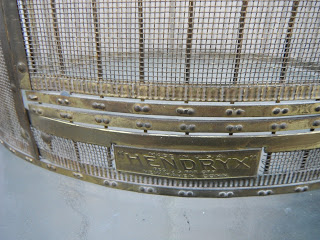Richard wrote to me asking for information about this cage. Let's see what we can figure out by examining the cage.
Looking at the cage, we can see that it is really reinforced. It has the heavy rails that arch up and over the top, 4 in all. Then there is the reinforcement where you can see the concentric arches at the top third of the sides. Richard wrote that it has cast iron feeders. From this picture, it looks like the feeders are porcelain on the inside. I don't see a tray in the bottom, but there would have been one originally. The cage is 18 in. X 16 in. and 21 in. tall.
It has the Hendryx tag
Wires are fairly far apart. From the size of the cage and the width of the wire spacing, this cage belongs to a larger type bird
Close-up view of the reinforced arches on the ends
Feeders are secured with the posts on either side and a latch on the back. Must have a pretty vigorous bird inside this cage.
I knew I'd seen it before, while going through my Hendryx trade catalogs, so I started searching.
What did I find out?
This is called the "Osborn Parrot Cage" in the 1926 and 1930 catalogs, and goes by the number OS84 in the 1932 catalog. I have no proof but by conjecture and a few cages labeled "Osborn", but I believe that the great cage manufacturer, Osborn, worked with Hendryx for a while. I believe that is why it carries the name "Osborn". I don't have a copy of the patent, but it is probably co-patented by both manufacturers. It is advertised: "This design ranks first among Parrot Cages, having no equal in construction and finish." The OS84 is described as "Specifically designed for Cockatoos with extra arch on each end to give added strength." The size for the OS84 was 21.25 in. X 15 in. with a height of 27.25 inches.
It is described like this in the 1932 catalog: "Solid brass throughout. Drilled rails. Moulding type drawer base. Grating over drawer. Cast iron porcelain enameled cups. Perch and swing."
What a great cage!! This cage is quite different from the other parrot cages we've seen previously on this blog. As of this writing, it is for sale on ebay.
Thanks to the welcomed information from one of my cage buddies, I am including a link to North Fork Pets and Antiques web site. The link will take you to the cage like this that they have for sale. It is a Victorian version that is labeled Osborn and Son, New York, NY. Very close to this one. It looks like the cage was modified a bit and the Hendryx name was put on it. Take a look:
http://www.tias.com/large-victorian-bird-cage-osborn-birdcage-new-york-361209.html
I enjoy doing the research and passing on the information to you. If you have any mystery cages you'd like me to check out, please feel free to write to me at my email address tweetthings53@gmail.com and include several pictures. You can't add pictures under comments here in the blog. I will feature the pictures as a guest contributor.
It's getting warm and the garage sale signs are out already. Keep your eyes open for great Hendryx cages as they get dusted off and see the light of day for the first time in ages.
Happy Hunting.
Barbara





















































